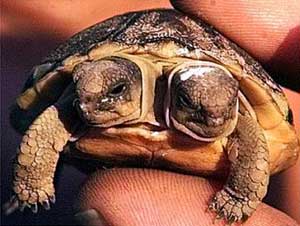You can raise them in constructed tanks or earthen ponds.
Pond Farming:
Area: 100 – 600 (m2). Depth: 1 – 1.5m. Transparency: 30cm
 |
|
Soft-shelled Turtle (Photo: african-safari) |
Clean water, active drainage, quiet surroundings, and proximity to the house for easy protection are essential. Surrounding the pond, or a portion of it, should have a garden area with shade trees and valuable fruit trees. The garden creates a very suitable ecological condition for the life of soft-shelled turtles raised in the pond. The pond’s bottom should have a thick layer of mud, about 10 – 20cm.
A wall around the pond should be built 0.7-0.8m high, with a 10cm wide ledge (toward the pond) to prevent turtles from escaping. The best distance between the pond and the protective wall is about 1m, where you can plant loofah, gourds, and fruit trees for shade.
The pond’s banks should be gently sloped or bridged, creating 1-2 pathways for turtles to easily climb up and sunbathe.
Tank Farming:
Area: over 10 (m2). Water depth: 0.6 – 1m. There should be an overflow drain (with a mesh screen) to maintain the highest water level, and a drain at the bottom for easy water removal to reduce the need for pumping.
You should also leave some land around the tank to plant shade trees, build bridges for turtle access, and create a submerged area covered with duckweed. If raising many turtles of different sizes, multiple ponds or sections should be created to separate larger and smaller turtles for individual care.
Stocking:
Before stocking, the pond or tank must be cleaned, filled with water, and the water quality tested as for fish farming.
The size of the stocked turtles should not be less than 50g each, ideally over 100g. Stocking should be uniform in size and done in February-March. The farming period lasts from April to November.
Stocking Density:
For turtles sized 50 – 100g, stock 10 – 15 turtles per (m2). For turtles sized 200g, stock 4 – 7 turtles per (m2).
Stocking density can be higher when the pond (or tank) has good water circulation, abundant food, and sufficient capital. If purchasing from wild catchers, choose healthy turtles (those that can right themselves when flipped over) and avoid sickly ones. Do not select turtles that have been caught with hooks or by electrical shock, as they are more likely to be injured or paralyzed. Choose turtles with a complete appearance, free from scratches or bleeding.
Feeding:
The feeding troughs for turtles should be stable. These troughs can be built from cement blocks, with 2 – 4 troughs installed in the pond (made of wood with walls 5-10cm high).
The troughs should be submerged 20cm deep. You can use bamboo trays submerged 20cm in water. The primary food consists of animal sources (live or dead) such as worms, snails, clams, shrimp, fish, beef or buffalo fat, intestines, lettuce, and by-products from slaughterhouses.
Food should be appropriately sized for the turtles’ mouths and fed regularly. You can actively cultivate food by raising fish such as carp, tilapia, and snails. Additionally, you can prepare mixed feed from starch, fish meal, and soybean meal to achieve a total protein content of 40 – 43%.
Note: Do not use salted fish meal or salted shrimp.
The daily feeding amount is about 5 – 8% of the turtles’ total weight in the pond. Before feeding, clean the troughs or platforms. Adjust the feeding according to weather conditions to avoid waste that affects water quality. Turtles eat well and are active when the water temperature is between 22 – 32oC; they eat less or stop when the temperature exceeds 35oC, and stop completely below 12oC.
In Northern regions, before winter, feed them high-nutrition and fatty foods such as buffalo or beef fat to help them accumulate fat for the winter. Raising turtles in less crowded ponds can be combined with raising fish such as carp, silver carp, or tilapia, as well as snails in the pond to provide food for the turtles, which will not harm them and will enhance the pond’s economic efficiency.
Management and Care:
– Prevent theft and avoid turtles escaping, especially during heavy rains, strong winds, when newly stocking, or during strong water currents that may stimulate them to escape or bite bait… a moment’s negligence can lead to losing the entire stock.
– Ensure quiet surroundings, limit water drainage, and avoid fishing activities that may cause panic.
– Keep the pond water clean, and do not let it become rotten.
– For turtle farming in winter (December to March), in addition to actively feeding before the cold season and during warm sunny days, implement measures to prevent cold by raising water levels and covering half of the pond with duckweed.
Harvesting and Transportation:
Selective Harvesting: You can go into the pond to catch them by hand, use nets, traps, or block access from the garden to the pond for direct catching. For full harvest: drain the pond completely to catch them. The main harvesting season is in November-December and January, when temperatures are low, and survival rates are high.
Transporting Soft-shelled Turtles: For nearby transport, you can place them in breathable sacks using bicycles or motorcycles. For longer distances, transport them in baskets or ventilated wooden crates, lined with duckweed to maintain moisture, layering duckweed and turtles alternately. It is best to place them in baskets or crates divided into multiple compartments, using trucks, airplanes, or trains. During transport, handle them gently to avoid bruising.


















































